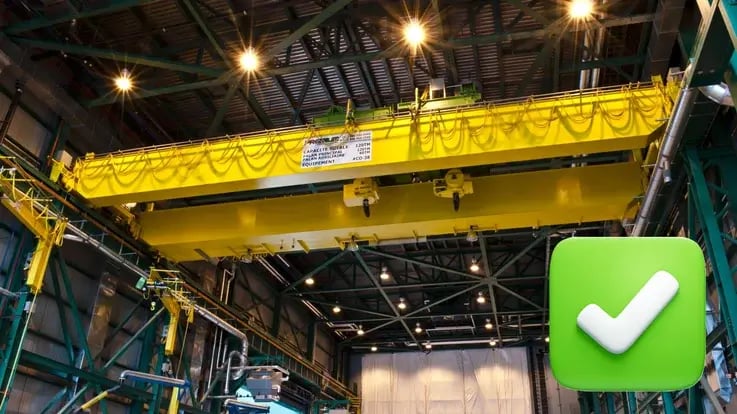The operator
-
PRODUCTSreturn
-
SERVICES AND PARTS
-
ABOUT US

Under the Regulation respecting occupational health and safety (RROHS), all lifting equipment must be inspected and comply with current standards and manufacturers' maintenance recommendations. This ensures maximum safety, and protects workers who use these devices to handle heavy loads. It is therefore for legal and safety reasons that inspection is a mandatory element for this type of equipment.
Our service team attaches the utmost importance to the inspection and maintenance of your lifting equipment. PREMIUM's comprehensive inspection and maintenance plans, detailed electronic inspection reports and prompt follow-up are all implemented by the PREMIUM team in accordance with current standards (CSA, CMAA, ASME, etc.) and the RULES OF THE ART to ensure the longevity and long-term productivity of your equipment fleet.
Premium Industrial Group 's service team can provide complete inspections for all brands of lifting equipment. All our technicians are certified and have a minimum of 8,000 hours' experience in the field of lifting equipment. After inspection, you receive a complete and detailed electronic report that you can keep in your records.
In accordance with the CSA B167-16 standard, lifting equipment must be inspected to ensure safety in the workplace. But how do you differentiate the different types of inspection for overhead cranes and other lifting equipment? Here's a summary of each type of inspection, to help demystify the issue.
The purpose of this inspection is to check the lifting equipment before it is used for each shift. It also includes confirmation that the equipment is shut down after that shift. Both checks must be carried out by the operator himself. The aim is to look for any anomalies before use, and to ensure that the equipment is safely shut down before the next shift. All this information should be recorded in the machine's daily logbook, which should be easily accessible to operators and supervisors.
The inspection at the start of the shift has 2 components: a de-energized inspection of the equipment, consisting of a visual check of essential components, and an energized inspection consisting of various tests of the equipment to ensure it is working properly.
The stationary inspection is carried out at the end of the shift. It involves checking that the machine is safely parked before the next shift.
%20(1).webp?width=496&height=421&name=image%20(53)%20(1).webp)
The operator
Before and after each shift.
Start of shift:
on/off checks.
End of shift:
safe parking.
Check the device before use.
On the ground.
Daily logbook (near the equipment).
The purpose of this inspection is to "detect faults, malfunctions and damage" to the equipment. For this reason, the inspection must be carried out by a "competent " and "qualified person " (CSA B167-16 6.4.1; 6.4.2 1) b)). It must also be carried out directly at the equipment, rather than from the ground.
Frequent inspection should be carried out at intervals that depend on the equipment's class of use , ranging from daily to monthly. To find out more about frequent inspection intervals for your equipment, you'll need to identify its class of use (A to F) and consult CSA B167-16 in section 6.4.1.
As part of the frequent inspection, the competent and qualified person will carry out an auditory and visual examination of essential equipment components, and write his or her observations in the equipment maintenance logbook.

Competent and qualified.
Daily to monthly, depending on class of use.
In-depth examination of essential components.
Detect faults, operating problems or damage.
Directly on the essential components.
Maintenance logbook.
The purpose of this inspection is to detect anomalies "to determine if they affect the safe operation of the lifting device." (CSA B167-16 6.5.2.1). In this case, it must be carried out by an "lifting device inspector " (CSA B167-16 6.5.1.1). It must also be carried out directly at the equipment, rather than from the ground.
Periodic inspection must be carried out at intervals that depend on the equipment's class of use , ranging from quarterly to annually. To find out more about the periodic inspection interval for your equipment, you'll need to identify its class of use (A to F) and consult CSA B167-16 in section 6.5.1.1.
As part of the periodic inspection, the inspector will focus on all components of the lifting device, in addition to the frequent inspection checks. He will base his examination on the manufacturer's instructions, or failing that, on a protocol drawn up by a competent person. He will write his observations in the equipment maintenance logbook.

Lifting equipment inspector.
Quarterly to annually, depending on class of use.
Examination of all components.
Identify any anomalies affecting safe operation.
Directly on all equipment.
Maintenance logbook.
%20(1).webp?width=496&height=421&name=image%20(53)%20(1).webp)
The operator
Before and after each shift.
Start of shift:
on/off checks.
End of shift:
safe parking.
Check the device before use.
On the ground.
Daily logbook (near the equipment).

Competent and qualified.
Daily to monthly, depending on class of use.
In-depth examination of essential components.
Detect faults, operating problems or damage.
Directly on the essential components.
Maintenance logbook.

Lifting equipment inspector.
Quarterly to annually, depending on class of use.
Examination of all components.
Identify any anomalies affecting safe operation.
Directly on all equipment.
Maintenance logbook.


- Number of equipment units
- Type (e.g., overhead crane, jib crane, monorail, gantry crane, fixed hoist)
- Number of hoists on each piece of equipment
Other relevant information (if available):
-A few photos of the equipment
- The most recent inspection report
- Annual inspection frequency or usage class
Confirm the address where the equipment is located.
Then click "Submit".
Once you've submitted this form, you'll shortly receive a confirmation e-mail indicating that we've received your request.
A member of our PREMIUM team will contact you within 24 hours (one business day or less) to verify the information and schedule your inspection.